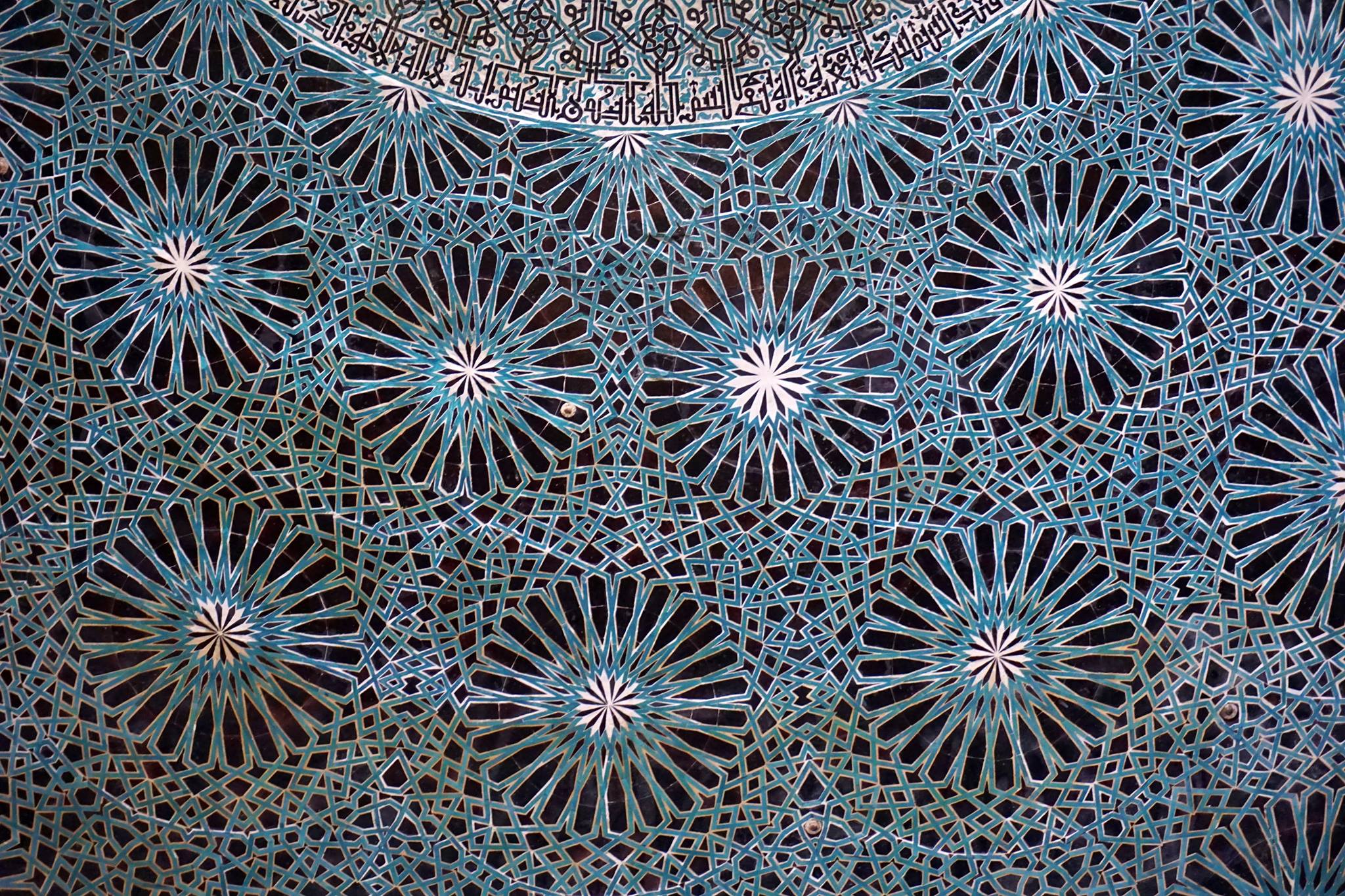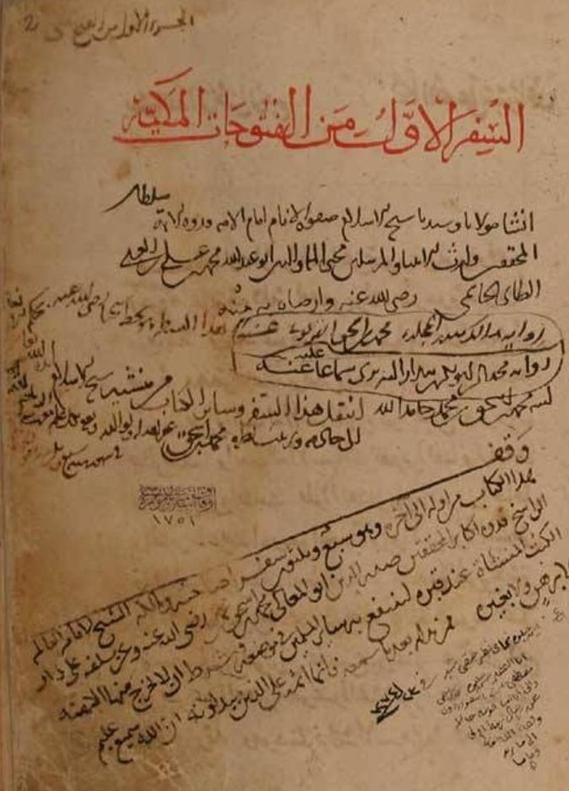Aaron Viengkhou on Sayyid Ḥaydar Āmulī's Scripturalization of Reality
Written on October 25th, 2021 by Aaron Viengkhou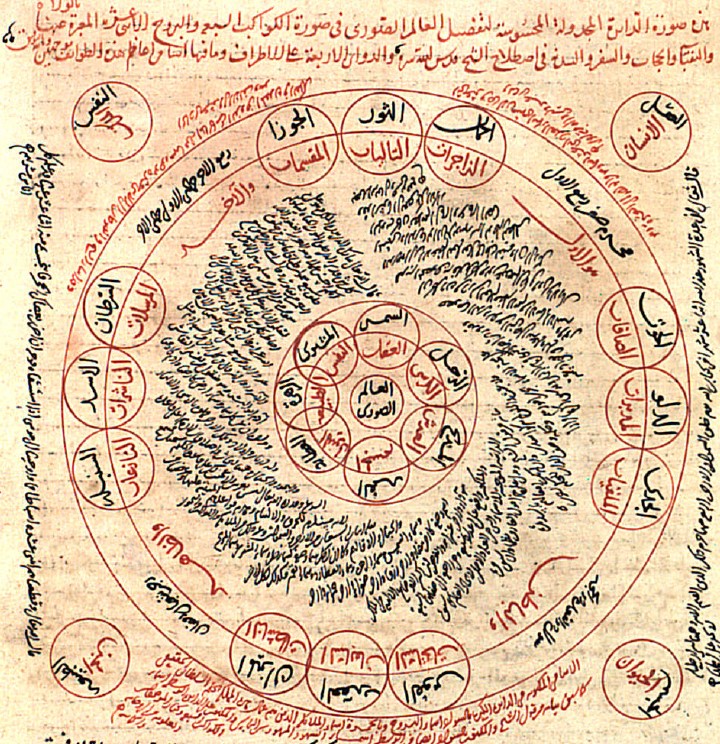
Sayyid Bahāʾ al-Dīn b. ʿAlī Ḥaydar al-Āmulī (d. after 782/1380) is remembered in the history of Islamic thought primarily for his synthesis of Twelver Shīʿism and Ṣūfism. He was not the first scholar to attempt a rapprochement of the two traditions, but he pursued the task with a hitherto unknown vigor—demonstrating the ultimate identity of Shīʿism and Ṣūfism can rightly be thought of as his life’s work. In the introduction to his famed Jāmiʿ al-asrār, for example, he sets the tone of the book by arguing that “Ṣūfī and Shīʿī are two different names indicating a single reality.”1 The synthesis of Shīʿism and Ṣūfism is also a key theme in two works which he wrote towards the end of his life, a Qurʾān commentary entitled al-Muḥīṭ al-aʿẓam, and a commentary on Ibn ʿArabī’s Fuṣūṣ al-ḥikam entitled Naṣṣ al-nuṣūṣ.
The most obvious historical context for assessing Āmulī and his work is to be found in the increasingly complex entanglements of the Shīʿī and Ṣūfī traditions in the 14th century. Importantly, however, Shīʿism and Ṣūfism, and the entanglements thereof, were also tangled up with other contemporaneous discourses, not least of which being the occult sciences. As Matthew Melvin-Koushki has amply shown, the post-Mongol period witnessed a steady Neopythagorean turn, closely aligned with Ṣūfī and Shīʿī currents, which, by the 15th century, blossomed into an exaltation of the science of letters (ʿilm al-ḥurūf), universal in scope and inextricably bound to knowledge of both God’s oneness (tawḥīd) and the arcanum of sanctified authority (walāya).2 Although Āmulī is silent on the subject of occult disciplines as practicable technologies, his oeuvre nevertheless exhibits many adjacencies with en vogue occult discourses, especially those with a Neopythagorean edge, including the science of letters.3 This is evident especially in his scripturalization of reality and his hermeneutic methodology.
The Procession of Tawḥīd
Āmulī was a systematic thinker whose entire worldview is constructed around the axial concept of tawḥīd. In Jāmiʿ al-asrār he describes the “virtues” (faḍāʾil) of tawḥīd as follows:
Existence (wujūd) in its entirety occurs in accordance with tawḥīd, comprehended by its ranks. All existents (mawjūdāt) are determined by it, created for its sake. All the prophets and sanctified authorities (awlīyāʾ)—upon whom be peace—were sent only to make it manifest and to summon humanity towards it. The axis of all the perfections and the foundation of all the stations, outwardly and inwardly, depend on it and its ranks. Knowledge of it is the epitome of all the sciences, both exoteric (rasmīya) and esoteric (ḥaqīqīya). It is the principle of religion and Islam, and the means for attainment of the garden and the fire.4
For Āmulī, then, any inquiry into metaphysics, sacred history, anthropology, epistemology, or theology is, at its base, an inquiry into tawḥīd. Unsurprisingly, his cosmology and hermeneutics are also deeply informed by his theory of tawḥīd.
Āmulī famously divides tawḥīd into what he terms “theological tawḥīd” (tawḥīd ulūhī) and “ontological tawḥīd” (tawḥīd wujūdī). The first of these, theological tawḥīd, encompasses the exoteric aspect (ẓāhir) of religious belief and is associated with the prophets and messengers; it is the tawḥīd professed by all believers and is expressed in the shahāda, the most basic ritual formula of Islamic monotheism, “there is no god but God” (lā ilāha illā Allāh). Ontological tawḥīd, meanwhile, encompasses the esoteric dimension (bāṭin) of religious belief and is associated with the sanctified authorities (awliyāʾ; i.e. the Shīʿī imāms and the Ṣūfī masters who, according to Āmulī, derive their wisdom from the imāms); as an esoteric doctrine, ontological tawḥīd is reserved for the elite and consists in the denial of ontological multiplicity and the affirmation of a singular absolute existence (wujūd muṭlaq).
By Āmulī’s time, this kind of ontological monism was widely discussed in terms of the highly controversial doctrine of “the oneness of existence” (waḥdat al-wujūd). Āmulī draws explicitly and extensively on well-known Ṣūfī theorists of waḥdat al-wujūd in articulating his own theory of ontological tawḥīd. As I argue elsewhere, his transition to the novel nomenclature of tawḥīd wujūdī is a deliberate attempt to rescue waḥdat al-wujūd from ignominy and present it as, in fact, the apotheosis of correct (if occluded) Islamic belief—an esoteric orthodoxy.5
To give a flavor of how Āmulī conceives of ontological tawḥīd, I would like to turn now to a consideration of four of the twenty-eight diagrams that accompany the muqaddima to Naṣṣ al-nuṣūṣ.
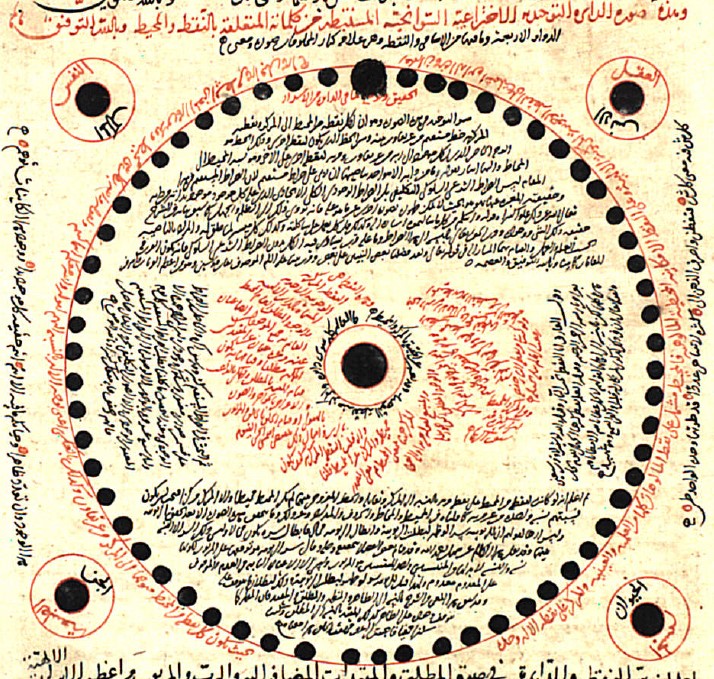 Figure 1: MS Carullah 1033, fol. 22v
Figure 1: MS Carullah 1033, fol. 22v
The diagram in Figure 1 occurs quite early in the text and is referred to by Āmulī as “the diagram of tawḥīd in the image of the central dot and the circumferential dot, indicative of the oneness of necessary existence and its multiplicity through its manifestation in the forms of contingent existence without any differentiation within its essence and reality.”6 The text within the diagram identifies the central dot as “the dot of tawḥīd” and explains that it represents absolute existence. The dots along the circumference represent individual existent things. What is most interesting about this diagram is that each of the existents along the circumference is said to be connected to absolute existence in the center by a “straight path” (ṣirāṭ mustaqīm). This Qurʾānic imagery is further augmented by the citation of Hūd, 56: “There is no walking creature except that He grasps it by its forelock, truly my Lord is on a straight path.” Ibn ʿArabī rather notoriously glossed this verse, saying, “Everything is walking upon the straight path of the Lord; in this sense, wrath is not upon them, nor are they astray.”7 Āmulī quickly points out that he is not considering the ṣirāṭ mustaqīm in terms of the observance of the sharīʿa, thereby distancing himself from the more provocative implications of the great shaykh’s pronouncement. But from an ontological perspective, Āmulī is in full agreement—insofar as existents are manifestations of absolute existence, they ineluctably traverse the paths prescribed for them and all of their paths are equally straight.
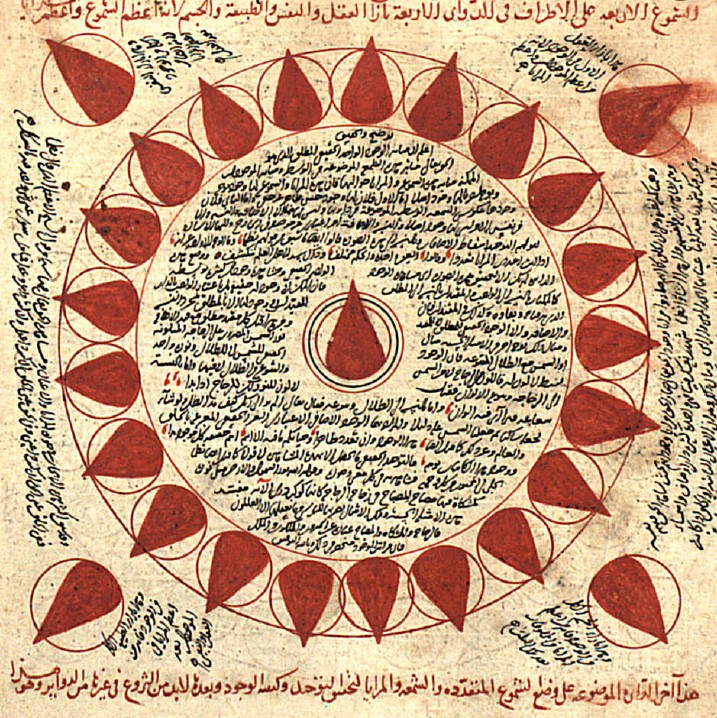 Figure 2: MS Carullah 1033, fol. 75v
Figure 2: MS Carullah 1033, fol. 75v
The relationship between absolute existence and individual existents (or between God and the world) is also visualized in another diagram (Figure 2). However, whereas the diagram in Figure 1 depicts ontological tawḥīd as a centripetal process whereby individual existents travel the straight path from the periphery towards absolute existence at the center, the diagram in Figure 2 depicts ontological tawḥīd as a centrifugal process with absolute existence radiating outwards from the center to the existents on the periphery, like a candle reflecting in the mirrors surrounding it. The text inscribed within the diagram begins:
Know that the one, real, absolute existence, which is the Real—may He be exalted!—is represented by the candle located in the center, and the contingent existents are represented by the candles and mirrors around it. In one sense, these candles and mirrors have existence, but, in another sense, they do not have existence at all. In the first sense, they have an apparent, real existence that is not concealed. In the second sense, their existence is the reflection in their circle of the candle located in the center, and they have only a relation and connection from [the central candle]. Were it not [for this reflection] they would have no existence at all in actuality…The inclusion of this diagram is only for the sake of verifying this form, that is to say, testifying to the one true existence and testifying to many existences through the mediation of [the true existence]…8
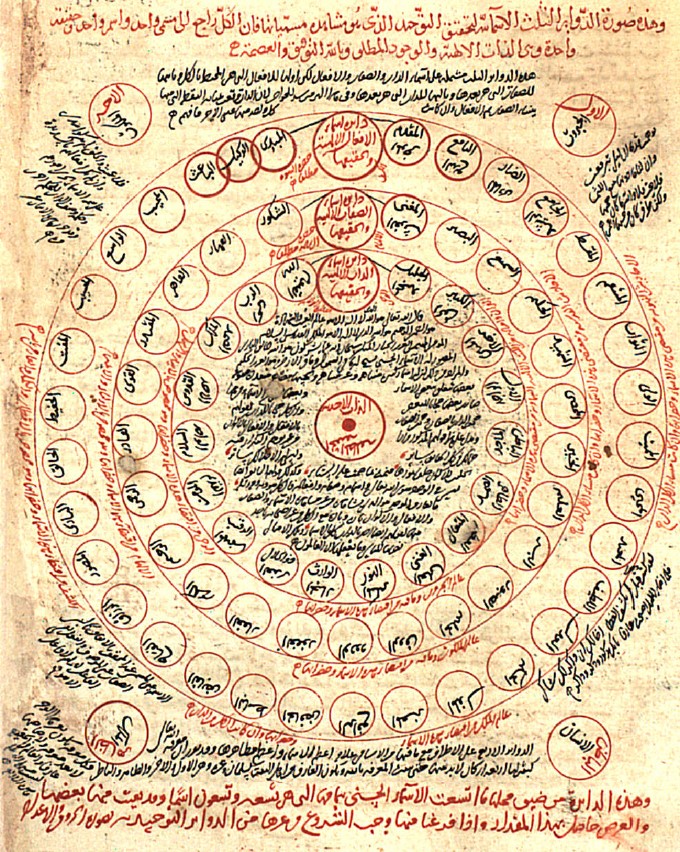 Figure 3: MS Carullah 1033, fol. 76v
Figure 3: MS Carullah 1033, fol. 76v
The diagram in Figure 3 illustrates ontological tawḥīd and the tension between oneness and manyness as an intra-divine phenomenon pertaining to the Divine Names. The diagram consists of four concentric circles: an outer circle populated with the thirty-seven Names of Actions (asmāʾ al-afʾāl), followed by a second circle containing the twenty-five Names of Attributes (asmāʾ al-ṣifāt), a third circle with the thirty-six Names of Essence (asmāʾ al-dhāt), and finally a central circle representing the One Essence (al-dhāt al-aḥadīya). Just as the singular absolute existence manifests itself in the multiplicity of individual existents, so is the multiplicity of the Divine Names expressive of an underlying unity. Āmulī thus explains:
In this arrangement is a secret for the elect, for the Essence is like the dot from which the Attributes and then the Acts originate, even though each one of them is identical to the other.9
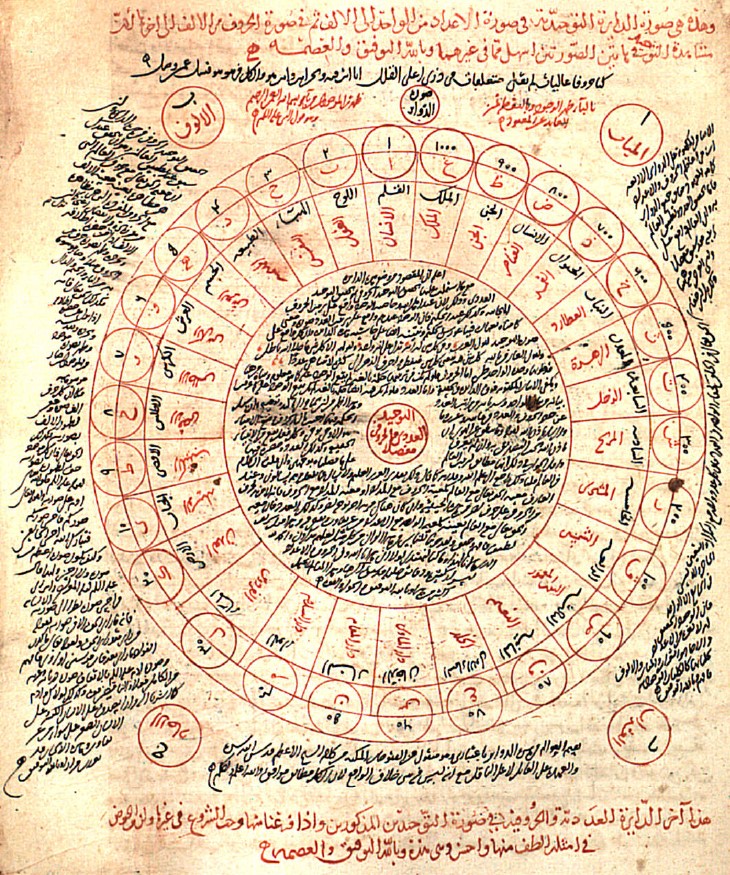 Figure 4: MS Carullah 1033, fol. 77
Figure 4: MS Carullah 1033, fol. 77
The diagram in Figure 4 once again represents the emergence of multiplicity from oneness, but this time in terms of “the tawḥīd of numbers and letters,” which Āmulī associates with both the People of Allāh and Pythagoras the Wise. In explaining the tawḥīd of letters, Āmulī writes:
…The concurrence of the Real—may He be exalted!—with the letters of the world—which are His loci of manifestation—is the same as the concurrence of the alif with the individual letters that are its loci of manifestation (maẓāhir) with no additions or subtractions. That is to say, when the alif descends from the presence of its absoluteness and its isolation and appears in the form of a letter, it becomes attributed (mawṣūf) with [that letter], whether it be bāʾ, jīm, dāl, etc. Likewise, when the Real—may He be exalted!—descends from the presence of His absoluteness and His isolation and His holiness, and appears in the form of an existent, He becomes attributed with it. Just as every letter is secretly an alif through the manifestation of alif in its form, so it is likewise with the Real—may He be exalted! Thus, every existent is a real through His manifestation in its form…10
The Three Books
In addition to showing how all the letters emerge from the letter alif and all the numbers emerge from the number 1, the diagram in Figure 4 is constructed so as to illuminate how the tawḥīd of numbers and letters “proceeds according to the correspondence (taṭbīq) of the worlds.” The diagram thus functions as a circular table of correspondences correlating the twenty-eight letters of the Arabic alphabet, numbers (1-9, 10-90, 100-900, 1000), and various features of the created universe—1:A:divine pen (al-qalam):human being (al-insān), 2:B:heavenly tablet (al-lawḥ):intellect (al-ʿaql), 3:J:dust cloud (al-habāʾ):soul (al-nafs), 4:D:nature (al-ṭabīya):roaming spirits (al-muhayyama), and so on.
Āmulī elaborates his theory of correspondences at great length in the muqaddimāt to his Qurʾān commentary, al-Muḥīṭ al-aʿẓam. It is not simply that letters, numbers, and the world are in correspondence through the enactment of the procession of tawḥīd, each in its own way. Rather, the correspondences derive from the fact that the world, like language, occurs entirely in accordance with number.11 That is to say, the world is both a linguistic and a numerical phenomenon. Āmulī therefore proposes a textualization of the cosmos that is at the same time a mathematization of the cosmos. Significantly, he confirms this point by citing a passage attributed to Pythagoras as recorded in the Epistles of the Brethren of Purity 12. But his textualization-mathematization of the cosmos is also a scripturalization insofar as creation is a divine self-disclosure (tajallī), a kind of revelation, analogous to and in correspondence with the Qurʾān.
He writes in the second muqaddima:
Know, o seeker,…that the book of Allāh is not specified only as the Qurʾān, nor as the Torah and the Gospel and others of the heavenly books. Neither are His verses/signs (āyāt) limited to the verses/signs of the Qurʾān and others of the books. Neither are His words [limited] to the words [of the Qurʾān]. Neither are His letters [limited] to the letters [of the Qurʾān]. Rather, the world, which is known as ‘the horizons’ (āfāq), is in its entirety the book of Allāh containing His verses/signs, His words, and His letters—it is the divine great book. And the human, which is known as ‘the souls’ (anfus), is also a divine comprehensive book containing His verses/signs, His words, and His letters—it is the divine small book. The first is known as ‘the great human,’ and the second [is known] as ‘the small human,’ for as they say: ‘The world is a great human, and the human is a small world.’ The Real—may He be exalted!—indicates them [i.e. the Book of Horizons and the Book of Souls] in His saying (Fuṣṣilat, 53), ‘We will show them our verses/signs in the horizons and in their souls until it is made clear to them that it is the truth. Does it not suffice that your Lord is Witness of all things? They are surely in doubt regarding the meeting with their Lord; He is surely Encompasser of all things.’13
In addition to the Qurʾān and the other scriptures brought by the prophets, God has revealed two further scriptures, the Book of Horizons (i.e. the created universe) and the Book of Souls (i.e. the human being). Insofar as the created universe and the human being are both books, they are, like the other scriptures, composed of letters, words, and verses/signs. The third, fourth, and fifth muqaddimāt of al-Muḥīṭ al-aʿẓam are devoted to analyzing respectively the letters, words, and verses/signs of the Book of Horizons and elucidating their correspondences with the letters, words, and verses/signs of the Qurʾān and the Book of Souls.
The “letters” of the Book of Horizons are the simple existents (mufradāt), the “words” are the composite existents (murakkabāt), and the “verses/signs” are the universals (juzʾīyāt). He explains, for example, that just as there are fourteen dotted letters and fourteen undotted letters in the Arabic alphabet, so are there fourteen simple existents in the mulk (prime matter, the four elements, and the nine spheres) and fourteen simple existents in the malakūt (the interiorities (bawāṭin) of prime matter, the four elements, and the nine spheres). Similarly, the three categories of word (noun, verb, preposition) appear in the Book of Horizons as the three kingdoms of nature (mineral, plant, animal), or else as the three classes of rational being (angel, human, jinn). Furthermore, the three short vowels (ḥarakāt) in Arabic—fatḥa, kasra, ḍamma—are mirrored by the three types of movements (ḥarakāt) in the sublunary world—upward (mustaqīm, associated with human beings), horizontal (ufqī, associated with animals), and downward (mankūs, associated with plants).14
In al-Muḥīṭ al-aʿẓam, Āmulī develops the correspondences between the Three Books—the Book of Horizons, the Book of Souls, and the Qurʾān—into a universal hermeneutic that elucidates his theory of ontological-esoteric tawḥīd through the application of Ṣūfī-Neopythagorean exegesis (taʾwīl). This is possible because each of the Three Books, insofar as it is a scripture revealed by God, conveys the truth of tawḥīd. For “the Masters of Esotericism and the People of the Way” (arbāb al-bāṭin wa ahl al-ṭarīqa), then, the practice of taʾwīl consists precisely in the uncovering of the correspondences between the Three Books, for knowledge of the world, knowledge of the human being, and knowledge of the Qurʾān equally amount to knowledge of God, and the exegesis of these Three Book results in God’s self-disclosure, His revelation, to the exegete.15
Conclusion: Diagramming Correspondences
Āmulī’s theory of correspondences follows from his theory of tawḥīd—every domain of reality (including number, language, the world, the human being) enacts the same process whereby multiplicity emerges out of oneness as an act of God’s self-disclosure, and, as a result, the domains of reality correspond with one another. Earlier in this blog post I introduced Āmulī’s theory of tawḥīd through an examination of four of the diagrams included in the muqaddima to Naṣṣ al-nuṣūṣ. These diagrams all exhibit a remarkable structural similarity. In fact, most of the other diagrams in Naṣṣ al-nuṣūṣ, as well as all the diagrams in al-Muḥīṭ al-aʿẓam, are modelled on the same basic circular pattern. In Naṣṣ al-nuṣūṣ, Āmulī explains his reasoning for constructing the diagrams as follows:
The purpose of all the diagrams is to fashion (tashkīl) that which occurred to us, by means of unveiling (kashf) and tasting (dhawq), of the divine gnoses and lordly realities into the form of intelligible models (amthila ʿaqlīya) and then into the form of sensible compositions (awḍāʿ ḥissīya) so as to facilitate the apprehension of what is intended and the attainment of what is sought.16
The diagrams, then, are pedagogical tools designed to communicate suprarational knowledge in visual form. Indeed, the diagrams appear in the text as visual aids depicting the topics under discussion. But the structural similarities among many of the diagrams—which illustrate subjects as varied as ontology, cosmology, prophetology, imāmology, psychology, anthropology, the Divine Names, the miʿrāj narrative, and so on—suggest a further function, namely to represent common sets of relations that obtain across different domains of reality. In other words, the circular diagrams are expressions of Āmulī’s theory of correspondences, fruits of his hermeneutic method, artifacts of taʾwīl.
I would like to conclude this piece with a brief reflection on two diagrams from Naṣṣ al-nuṣūṣ that explicitly visualize the correspondence theory of hermeneutics. Āmulī’s favorite subject for exegesis, to which he returns again and again in his works, is the basmala. In his commentary on the khuṭba of Ibn ʿArabī’s Fuṣūṣ, for example, he explains that when God sent down (inzāl) the Qurʾān and existentiated (ījād) the world and the human being, He began (ibtadaʾa) each of the Three Books with the phrase “In the name of God, the Gracious, the Merciful” (bi-smi llāhi l-raḥmāni l-raḥīm). The basmala is thus “the principle of each of the divine worlds and the source of each of the heavenly books.”17
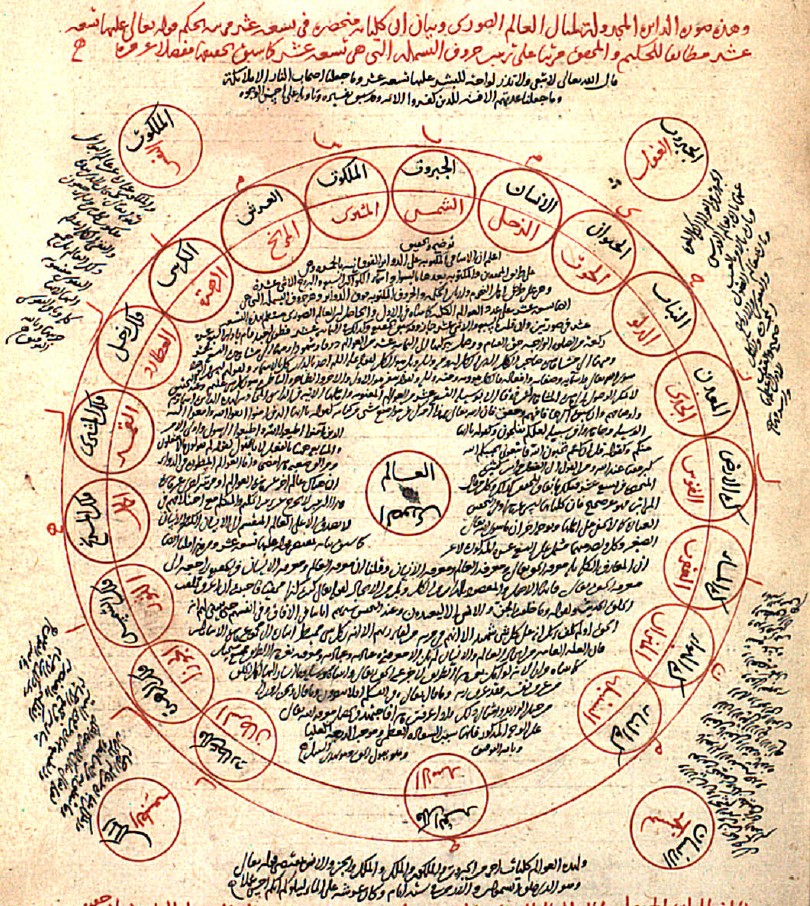 Figure 5: MS Carullah 1033, fol. 62
Figure 5: MS Carullah 1033, fol. 62
Consistent with Āmulī’s commitment to the primacy of number, his exegesis of the basmala centers on the number 19, this being the number of consonants and long vowels constituting the written phrase (BSMALLHALRḤMNALRḤĪM). Just as the Qurʾān is epitomized in the nineteen letters of the basmala, so are the Book of Horizons and the Book of Souls. In the Book of Horizons, the nineteen letters are expressed in two ways. On the one hand, the Universal Intellect, the Universal Soul, the nine heavenly spheres, the four elements, the three kingdoms of nature, and the human being (1+1+9+4+3+1=19) together constitute the nineteen levels of the cosmic hierarchy. On the other hand, the nineteen letters are spangled across the firmament with the seven planets and the twelve zodiacal constellations (7+12=19).18 These manifestations of the number 19 are illustrated in Figure 5, where the letters of the basmala sit atop the circles surrounding the circumference which enumerate the two sequences of 19—B:jabarūt (i.e. Universal Intellect):Sun, S:malakūt (i.e. Universal Soul):Jupiter, M:ʿarsh (i.e. Sphere of Atlas):Mars, A:kursī (i.e. Sphere of the Zodiac):Venus, and so on.
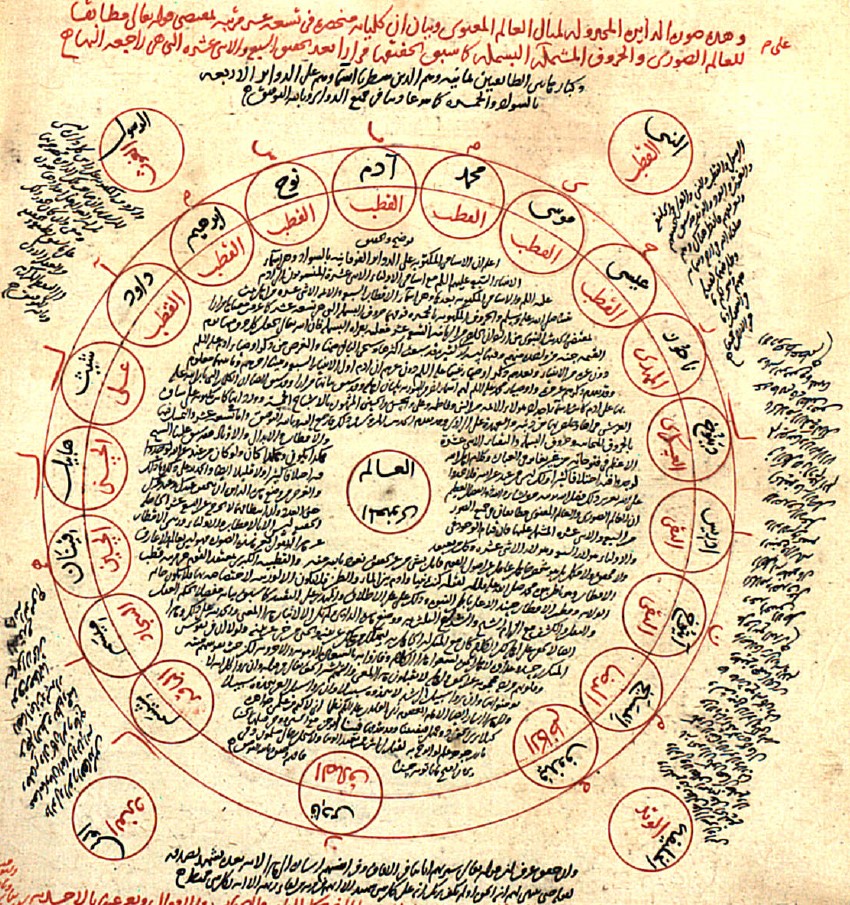 Figure 6: MS Carullah 1033, fol. 62v
Figure 6: MS Carullah 1033, fol. 62v
As for the Book of Souls, it also is composed in accordance with the number 19, again in two ways. First, human psychology can be analyzed into nineteen components, the particular intellect, the particular soul, the five exterior senses, the five interior senses, the four souls (amāra, lawwāma, mulhama, and muṭmaʾanna), and the three spirits (mineral, vegetable, and animal) (1+1+5+5+4+3=19).19 The second manifestation of the number 19 concerns the cycles of prophecy (nubūwa) and sanctified authority (walāya), for each of the seven major prophets (Adam, Noah, Abraham, David, Moses, Jesus, Muḥammad) is succeeded by twelve awlīyāʾ (7+12=19). Āmulī depicts the cycles of nubūwa and walāya in the diagram in Figure 6. As with the previous diagram, this one features the letters of the basmala inscribed over the nineteen circles along the circumference. Seven of these circles contain the names of the seven major prophets written in black ink, and beneath the name of each prophet, written in red ink, occurs the word “pole” (quṭb) to denote the position of the prophets at the apex of the spiritual hierarchy. The remaining twelve circles contain the names of the awlīyāʾ of Adam (black ink) and the awlīyāʾ of Muḥammad, namely the imāms of Twelver Shīʿism (red ink).
In Naṣṣ al-nuṣūṣ and elsewhere, Āmulī goes on to articulate a considerably more complex exegesis of the nineteen letters of the basmala as they are encoded within the Book of Horizons and the Book of Souls.20 He also produces other diagrams that visualize the manifestations of the number 19 in the cosmic and human domains from different perspectives. It is hoped, however, that this short analysis of the diagrams in Figures 5 and 6 will have sufficiently introduced the reader to Āmulī’s theory of correspondences and its application as a universal hermeneutic addressed to a scripturalized reality.
Author Bio
Aaron Viengkhou is a PhD candidate in the Department of Near Eastern Languages and Civilizations at Harvard University. He is currently engaged in researching and writing a dissertation tentatively titled “(Con)tested Belief: Ḥaydar Āmulī’s Synthetic Intervention in the Shīʿī and Ṣūfī Traditions.” The project is, of course, concerned with arriving at a better understanding of the life and thought of Ḥaydar Āmulī (d. after 782/1380), a crucial figure in the history of Shīʿī-Ṣūfī engagement. In doing so, however, Aaron is specifically interested in delineating the contours of 14th century Ṣūfism and Shīʿism, and determining the ways in which Āmulī attempted to both assimilate and disrupt the two traditions so as to arrive at a synthesis. More generally, Aaron’s research interests are directed towards mapping the tangled web of intersections and tensions between various discursive fields (especially philosophy, theology, esotericism, and occultism) in the intellectual culture of the premodern Islamicate world.
Copyright Aaron Viengkhou, 2021.
-
Ḥaydar Āmulī, Jāmiʿ al-asrār wa manbaʿ al-anwār bih inḍimām-i Risālah-i Naqd al-nuqūd fī maʿrifat al-wujūd, eds. Henry Corbin and ʿUthmān Yaḥyá (Tehran: Anjuman-i Īrānshināsī-i Farānsah va Shirkat-i Intishārāt-i ʿIlmī va Farhangī, 1989), 41. ↩
-
Matthew Melvin-Koushki, “Powers of One: The Mathematicalization of the Occult Sciences in the High Persianate Tradition,” Intellectual History of the Islamicate World 5 (2017): 127-199. ↩
-
For an excellent recent study of Āmulī’s employment of occult sciences, including letters, astrology, and alchemy, see Mohammad Amin Mansouri, “Walāya between Letterism and Astrology: The Occult Mysticism of Sayyid Ḥaydar Āmulī (d. c. 787/1385),” Journal of Sufi Studies 9 (2020): 161-201. ↩
-
Jāmiʿ al-asrār, 49-50. ↩
-
Aaron S. Viengkhou, “Tawḥīd Divided: The Esoteric Orthodoxy of Sayyid Ḥaydar Āmulī (d. after 782/1380),” La Rosa di Paracelso 2 (2020) (forthcoming). ↩
-
Ḥaydar Āmulī, Naṣṣ al-nuṣūṣ fī sharḥ al-fuṣūṣ li-Muḥyī al-Dīn Ibn ʿArabī, ed. Muḥsin Bīdārfar, 3 vols. (Qum: Manshūrāt-i Bīdār, 2015), 1:168. ↩
-
Muḥyī al-Dīn Ibn ʿArabī, Fuṣūṣ al-ḥikam, ed. Abū al-ʿAlá ʿAfīfī (Beirut: Dār al-Kitāb al-ʿArabī, n.d.), 106. ↩
-
Āmulī, Naṣṣ al-nuṣūṣ, 2:622-23. ↩
-
Ibid., 2:629. ↩
-
Ibid., 2:632. ↩
-
Ḥaydar Āmulī, Tafsīr al-Muḥīṭ al-aʿẓam wa-al-baḥr al-khiḍamm fī taʾwīl Kitāb Allāh al-ʿazīz al-muḥkam, ed. al-Sayyid Muḥsin Mūsawī al-Tibrīzī (Tehran: Muʾassasat al-Ṭibāʿah wa-al-Nashr, Wizārat al-Thaqāfah wa-al-Irshād al-Islāmī, 1995), 2:436-37. ↩
-
Ibid., 2:437-38. This quotation attributed to Pythagoras is also cited in Naṣṣ al-nuṣūṣ, 1:458-61. ↩
-
Āmulī, al-Muḥīṭ al-aʿẓam, 2:15. ↩
-
Ibid., 2:433-34. ↩
-
Ibid., 1:240-42. For a translation and analysis of this passage, see Nicholas Boylston, “Qurʾānic Exegesis at the Confluence of Twelver Shīʿism and Ṣūfism: Sayyid Ḥaydar Āmulī’s al-Muḥīṭ al-aʿẓam,” Journal of Qurʾanic Studies 23, no. 1 (2021), 15-17. ↩
-
Āmulī, Naṣṣ al-nuṣūṣ, 1:42. ↩
-
Ibid., 2:859-61. ↩
-
Ibid., 1:464. ↩
-
Ibid., 1:468-69. ↩
-
For a rich and detailed phenomenological analysis of Āmulī’s exegesis of the number 19, see Henry Corbin, Temple and Contemplation, trans. Philip Sherrard and Liadain Sherrard (London: KPI Limited, 1986), 81-103. For a more recent study of Āmulī’s exegesis of the letters of the basmala, see Mansouri, especially 181-91. ↩
